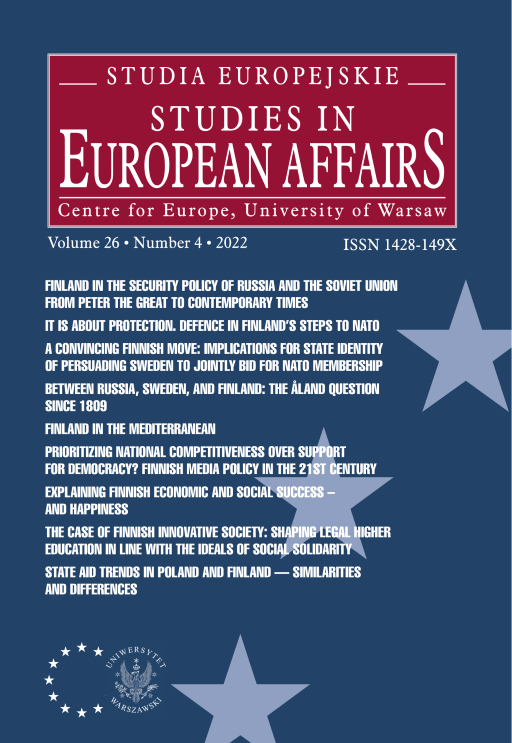
ISSUE: 4/2022
- Volume 26
- Number 4
- 2022
Subscribe NEWSLETTER
Studia Europejskie –
Studies in European Affairs
ISSN: 1428-149X
e-ISSN: 2719-3780
License
Articles published in the journal are under a Creative Commons Attribution – Non Commercial – No Derivatives 4.0 International License
Explaining Finnish Economic and Social Success – And Happiness
Abstract
This article explores the reasons behind the high economic and social rankings for Finland. It also reflects on why Finland is considered the “happiest” country in the world (according to a World Happiness Report). Using empirical data from two studies – an article comparing high-andlow-tax countries, and the aforementioned recent World Happiness Report – it compares Finland with its Nordic neighbours and other Western, especially Anglo-American, countries. The essay outlines a so-called “Finnish model’ and looks for the roots of this model. Comparing measures in several dimensions – effort, culture, institutions, and economic and social outcomes – the essay tries to fi nd characteristics that are particular for Finland. Education, innovation, and economic security, as well as trust, gender equality, resilient confl ict solutions, and geo-historical luck, are crucial to Finland’s success. Three notable Germans – Luther, Hegel, and Marx – have influenced Finnish culture and society in different ways. Is Finland the country that comes closest to the ideal – “From each according to his ability, to each according to his needs” (Marx, 1875).
References
Andersson, J.O., Kosonen, P. and Vartiainen, J. (1993) The Finnish Model of Economic and Social Policy – From Emulation to Crash. Åbo: Åbo Akademi.
Blanc, E. (2022) Revolutionary Social Democracy. Working-Class Politics Across the Russian Empire (1882–1917). Chicago: Haymarket Books.
Brooks, N. and Hwong, T. (2006) The Social Benefits and Economic Costs of Taxation. A Comparison of High- and Low-TaxCountries. Ottawa: Canadian Centre for Policy Alternatives.
Bunker, S.G. (2007) Natural values and the physical inevitability of uneven development under capitalism in Hornborg, A., McNeill, J.R. and Martinez-Alier, J. (eds.) Rethinking environmental history. Lanham: Altamira, pp. 239–258.
Castells, M. and Himanen, P. (2003) The Information Society and the Welfare State: The Finnish Model. Oxford: Oxford University Press.
Helliwell, J.F. et al. (eds.) (2022) World Happiness Report 2022. New York: Sustainable Development Solutions Network. Available at: https:// worldhappiness.report/ed/2022/ (Access 22.09.2022).
Kagarlitsky, B. (2006) The Revolt of the Middle Class. Cultural Revolution. Moscow: Kulturnaya revolutsiya.
Kalland, M. (2003) ”I dag kolumnen”, Hufvudstadsbladet. 23.03.2003.
Landes, D.S. (1998) The Wealth and Poverty of Nations. Why Some Are so Rich and Some so Poor. New York: W.W. Norton.
Lewis, R. (1999) Cross Cultural Communication – A Visual Approach. London: Transcreen Publications.
Lewis, R. (2005) Finland, Cultural Lone Wolf. Yarmuth, ME: Intercultural Press.
Marx, K. (1875) Critique of the Gotha Programme. Available at: https://www.marxists.org/archive/marx/works/1875/gotha/ (Access 1.11.2022).
Mjøset, L. (ed.) (1986) Norden dagen derpå. De nordiske ekonomisk-politiske modellene og deres problemer på 70- og 80-tallet. Oslo: Universitetforlaget och Samfundslitteratur.
Mjøset, L. (1987) “Nordic Economic Policies in the 1970s and 1980s”, International Organization. Vol. 41(3), pp. 403–456.
Teivainen, A. (2022) “Finland Retains Top Spot in Global Happiness Report”, Good News from Finland. Available at: https://www.goodnewsfi nland.com/finland-retains-top-spot-in-global-happinessreport/ (Access 1.09.2022).
DOI: 10.33067/SE.4.2022.7
Language: English
Pages: 177-198
How to Cite:
Harvard
Andersson, J. (2023) "Explaining Finnish Economic and Social Success – And Happiness". Studia Europejskie – Studies in European Affairs, 4/2022, pp. 177-198. DOI: 10.33067/SE.4.2022.7